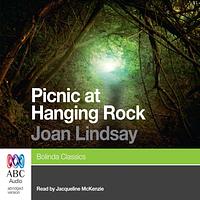You need to sign in or sign up before continuing.
Take a photo of a barcode or cover
adventurous
dark
emotional
mysterious
sad
fast-paced
Plot or Character Driven:
A mix
Strong character development:
Yes
Loveable characters:
Yes
Diverse cast of characters:
No
Flaws of characters a main focus:
Complicated
A classic of Australian literature with a mystery extending outside of the book and into reality.
A favourite of my childhood that I believe is a must read for all.
A favourite of my childhood that I believe is a must read for all.
dark
mysterious
reflective
sad
tense
slow-paced
Plot or Character Driven:
A mix
Loveable characters:
Complicated
mysterious
reflective
slow-paced
Plot or Character Driven:
Plot
Strong character development:
No
Loveable characters:
No
Diverse cast of characters:
No
Flaws of characters a main focus:
Yes
adventurous
dark
mysterious
reflective
tense
medium-paced
Plot or Character Driven:
A mix
Strong character development:
No
Loveable characters:
Complicated
Diverse cast of characters:
Complicated
Flaws of characters a main focus:
No
‘Picnic en Hanging Rock’ de Joan Lindsay es una novela gótica que en lugar de estar ambientada en los nebulosos páramos ingleses está ambientada en el caluroso verano australiano. Es un relato fantástico en el que no sucede nada fantástico y una novela de misterio sobre un misterio que es investigado pero que no queda resuelto. El adjetivo que mejor le queda es “inquietante”. Aunque no suceda nada sobrenatural ni terrorífico es inquietante porque no hay nada más inquietante que lo que escapa a nuestra comprensión, lo que queda sin ser explicado.
La novela empieza con un misterio que no se resuelve y termina con otro que tampoco acaba de quedar del todo claro. Empieza cuando unas alumnas de un estricto internado para chicas, acompañadas de dos de sus profesoras, van a celebrar un picnic el día de San Valentín del año 1900. Las chicas marchan contentas e ilusionadas, radiantes de belleza y serenidad, pero cuando regresan al colegio (mucho más tarde de lo previsto) llegan llorando, histéricas y angustiadas; durante la excursión tres alumnas y una profesora han desaparecido sin dejar rastro.
La novela nos viene a decir que estos hechos ocurrieron realmente, pero tampoco está claro. Lo que sí es cierto es que la novela está escrita como si fuera una recreación novelada de unos hechos verídicos, lo que ayuda a que sea tan inquietante como es. Pero ‘Picnic en Hanging Rock’ no sólo es inquietante y misteriosa y etérea y todas estas cosas. Es también una comedia irónica y crítica de las costumbres victorianas.
Pero aún hay más. Y es que Joan Lindsay consiguió escribir una novela riquísima, con múltiples lecturas, que parece inagotable. Habla también del fin de la inocencia (sexual) y de represión (sexual). Es una novela compleja y sutil, que además deja caer algo de subtexto homoerótico aquí y un poco de subtexto lésbico allí. Está escrita con un estilo elegante, algo irónico y distanciado, realmente delicioso. Es realmente una maravilla.
La novela empieza con un misterio que no se resuelve y termina con otro que tampoco acaba de quedar del todo claro. Empieza cuando unas alumnas de un estricto internado para chicas, acompañadas de dos de sus profesoras, van a celebrar un picnic el día de San Valentín del año 1900. Las chicas marchan contentas e ilusionadas, radiantes de belleza y serenidad, pero cuando regresan al colegio (mucho más tarde de lo previsto) llegan llorando, histéricas y angustiadas; durante la excursión tres alumnas y una profesora han desaparecido sin dejar rastro.
La novela nos viene a decir que estos hechos ocurrieron realmente, pero tampoco está claro. Lo que sí es cierto es que la novela está escrita como si fuera una recreación novelada de unos hechos verídicos, lo que ayuda a que sea tan inquietante como es. Pero ‘Picnic en Hanging Rock’ no sólo es inquietante y misteriosa y etérea y todas estas cosas. Es también una comedia irónica y crítica de las costumbres victorianas.
Pero aún hay más. Y es que Joan Lindsay consiguió escribir una novela riquísima, con múltiples lecturas, que parece inagotable. Habla también del fin de la inocencia (sexual) y de represión (sexual). Es una novela compleja y sutil, que además deja caer algo de subtexto homoerótico aquí y un poco de subtexto lésbico allí. Está escrita con un estilo elegante, algo irónico y distanciado, realmente delicioso. Es realmente una maravilla.
This would have been unbearably boring, were it not for the strong homoerotic themes throughout (that probably weren't intentional, but I have to get my jollies where I can).
... Anyway; this very in-depth Reddit review is way more thorough than anything I care to say. Good on whoever wrote it.
... Anyway; this very in-depth Reddit review is way more thorough than anything I care to say. Good on whoever wrote it.
dark
mysterious
sad
medium-paced
Plot or Character Driven:
Plot
Strong character development:
No
Loveable characters:
No
Diverse cast of characters:
No
Flaws of characters a main focus:
Complicated
A short book, easy to read about a mysterious disappearance at Hanging Rock.
No real resolution to the story so felt like an unsatisfying ending.
No real resolution to the story so felt like an unsatisfying ending.
dark
mysterious
reflective
slow-paced
Plot or Character Driven:
Plot
Strong character development:
No
Loveable characters:
Complicated
Diverse cast of characters:
No
Flaws of characters a main focus:
Complicated
The picnic setting of Hanging Rock in Australia in 1900 is eerie and feels like it belongs to another world, as if another reality has bled into the idea of what we perceive as nature.
A boarding school for Young Ladies run by the formidable Mrs Appleyard has a summer school trip for a picnic in the geological marvel of the rocks. A place that is majestic, beautiful, isolated and imbued with a dream like quality in the blazing sunshine.
A group of four girls go off exploring and later one returns in hysterics with no idea of what has happened to the other three.
One member of school staff seen wandering in their direction also disappears.
The search is called off as darkness approaches and the party arrive back at school late, tired & forlorn, disrupting Mrs Appleyard's timekeeping, school reputation and control of the girls.
Search parties provide no clue as to what has happened to the missing girls and tutor. Have they been murdered? Abducted? Killed by wild animals? Fallen and trapped and slowly dying?
The narrative is left open ended. There is no resolution to the mystery making it feel even more sinister. Possibly even supernatural.
The disappearance happens early in the novel and then the event begins to have an effect on those involved and then an increasing number of people in the surrounding community.
More tragedy follows as if the initial event is casting longer shadows reaching out to claim more victims.
It's written like a true account and the author asks the reader to decide whether it is fact or fiction. 'As the fateful picnic took place in the year nineteen hundred, and all the characters who appear in this book are long since dead, it hardly seems important.'
A boarding school for Young Ladies run by the formidable Mrs Appleyard has a summer school trip for a picnic in the geological marvel of the rocks. A place that is majestic, beautiful, isolated and imbued with a dream like quality in the blazing sunshine.
A group of four girls go off exploring and later one returns in hysterics with no idea of what has happened to the other three.
One member of school staff seen wandering in their direction also disappears.
The search is called off as darkness approaches and the party arrive back at school late, tired & forlorn, disrupting Mrs Appleyard's timekeeping, school reputation and control of the girls.
Search parties provide no clue as to what has happened to the missing girls and tutor. Have they been murdered? Abducted? Killed by wild animals? Fallen and trapped and slowly dying?
The narrative is left open ended. There is no resolution to the mystery making it feel even more sinister. Possibly even supernatural.
The disappearance happens early in the novel and then the event begins to have an effect on those involved and then an increasing number of people in the surrounding community.
More tragedy follows as if the initial event is casting longer shadows reaching out to claim more victims.
It's written like a true account and the author asks the reader to decide whether it is fact or fiction. 'As the fateful picnic took place in the year nineteen hundred, and all the characters who appear in this book are long since dead, it hardly seems important.'
I first found out about this book from watching the film adaptation by Peter Weir, which I fell in love with and instantly became one of my favourite films of all time. When I discovered that the film was based on a book, of course I had to read it. I couldn't find it anywhere, so I went to B&B and ordered it online. It was pricey, and I had to wait for like a month for shipping.
I did that in 2017. I began actually reading the book this January.
Basically, I wanted to read this book in the right time. It's a bit like taking a long-awaited vacation. When you finally get to the destination, you want to slow down and savour everything.
And wow, was this book worth it. I regret nothing, not the price, the months spent waiting for the right moment.
Of course I knew what the story was about. The film was faithful, not only in terms of plot or characterisation, but more importantly in terms of tone. But this is about the book, not the film.
The bulk of the story is, in a way, quite simple. A group of schoolgirls with two teachers go on a picnic at Hanging Rock on Valentine's Day, 1990. Three of them, along with the senior teacher, climb the rock and never to be seen again, except for one (who has no memory of the climb). The book begins with the picnic day and ends around a month later. Neither the characters nor the readers ever find out what actually happened on the Rock that day.
What makes this book rich is in its steadfast refusal to provide answer to the mystery. Instead, it delves into the lives of the characters; everyone whose life is affected by the occurrence. It concerns itself more with the relationships formed and broken, with how the tragedy reveals people's true colours.
Joan Lindsay has a way of writing that creates vivid scenes with little description, especially when she's writing about nature. I love how the surrounding environment/nature (especially the Hanging Rock itself) is as much a character as any of the people involved.
I've only read this book once, but I already put it in my all time favourites list. Just like Irma Leopold knows with just one glance that Mike is her beloved, so did I know.
Update: Rereading (25th of March, 2019)
On the reread, it became clear how much foreshadowing Lindsay wrote the first few chapters.
I did that in 2017. I began actually reading the book this January.
Basically, I wanted to read this book in the right time. It's a bit like taking a long-awaited vacation. When you finally get to the destination, you want to slow down and savour everything.
And wow, was this book worth it. I regret nothing, not the price, the months spent waiting for the right moment.
Of course I knew what the story was about. The film was faithful, not only in terms of plot or characterisation, but more importantly in terms of tone. But this is about the book, not the film.
The bulk of the story is, in a way, quite simple. A group of schoolgirls with two teachers go on a picnic at Hanging Rock on Valentine's Day, 1990. Three of them, along with the senior teacher, climb the rock and never to be seen again, except for one (who has no memory of the climb). The book begins with the picnic day and ends around a month later. Neither the characters nor the readers ever find out what actually happened on the Rock that day.
What makes this book rich is in its steadfast refusal to provide answer to the mystery. Instead, it delves into the lives of the characters; everyone whose life is affected by the occurrence. It concerns itself more with the relationships formed and broken, with how the tragedy reveals people's true colours.
Joan Lindsay has a way of writing that creates vivid scenes with little description, especially when she's writing about nature. I love how the surrounding environment/nature (especially the Hanging Rock itself) is as much a character as any of the people involved.
I've only read this book once, but I already put it in my all time favourites list. Just like Irma Leopold knows with just one glance that Mike is her beloved, so did I know.
Update: Rereading (25th of March, 2019)
On the reread, it became clear how much foreshadowing Lindsay wrote the first few chapters.







